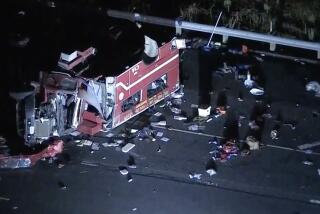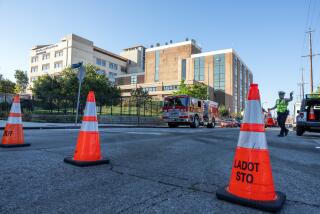Asiana plane crash: A Stanford Hospitalâs disaster drill paid off
SAN FRANCISCO â The staff at Stanford Hospital conducted a disaster drill a few weeks ago, a routine reminder for doctors and nurses on what to do if patients started pouring in.
Those skills were put to the test Saturday afternoon, when the Palo Alto medical center and its childrenâs hospital took in 55 patients from the Asiana Airlines Flight 214 crash at San Francisco International Airport.
The hospital was notified about a âpotential mass casualty occurrenceâ about noon, roughly 30 minutes after the Boeing 777 slammed into the runway, said Dr. Robert Norris, Stanfordâs chief of emergency medicine.
At 12:06 p.m., the hospital paged a variety of staff â physicians, nurses, administrators â telling them to stand by for a âcode triage.â That signals âsomething has happened in the community and we may need to muster resources,â Norris said.
âWhen we got word that there were upwards of 290 patients being triaged, a âcode triage majorâ was initiated,â Norris said.
That activated the disaster plan: a command center and triage area were set up; operating rooms were cleared and readied.
The first two patients, brought in by a U.S. Coast Guard helicopter about 2 p.m., âwere pretty sick,â Norris said.
About a half-hour later, San Mateo emergency services notified the hospital that it was beginning to transport patients by ground.
Initially, the injured went to San Francisco General Hospital, which is closer to the airport, Norris said. But soon passengers were coming to Stanford. Eight more patients were brought in before word came that as many as 50 were on their way.
By about 4:30 p.m., 35 people had been taken to the hospital, Norris said. Ultimately, 20 more would come.
Because the passengers had been triaged by teams at the crash site, they came to the hospital with varying degrees of injuries, Norris said.
Once at Stanford, staff assessed what treatment they needed â each accompanied by an attending physician, a resident and nurses.
Korean- and Mandarian-speaking hospital staff jumped in to translate. X-rays and lab work were taken. Bedside ultrasounds were conducted to evaluate abdominal injuries.
Those who suffered minor injuries and didnât need to be admitted were moved to another area of the hospital to begin the logistics of getting released â which became problematic because some passengers had not even been through U.S. Customs at the airport.
Even those who were allowed to leave were also checked by a doctor again âjust to make sure something hadnât fallen through the cracks,â Norris said.
Of the 55 patients the hospital eventually treated Saturday, 11 adults were admitted to Stanford Hospital, and seven children were admitted to Lucile Packard Childrenâs Hospital.
As of Tuesday morning, only five remained, with one in critical but stable condition.
[Updated, 5:42 p.m.: Hospital officials released new numbers late Tuesday afternoon, saying only four people remain hospitalized.]
Their injuries included severe spinal fractures, liver injuries, fractures and âa lot of bumps and bruises,â Norris said.
âBut amazingly,â he said, âthese people were well.â
Norris said it is the biggest disaster the hospital has responded to since the magnitude 6.4 Loma Prieta earthquake struck the Bay Area in 1989.
The hospital staff has been debriefed on its response, he said, and have noticed a few things that could be improved â such as coping with language barriers. But overall, he said, âit went very well.â
âTo be honest with you, it was a phenomenal test of our system,â he said, adding later: âThe key to this is being practiced at it and drilling. If you try to adopt a plan or hope that a plan that is completely alien to your staff will work, it wonât.â
[For the record, July 12: An earlier version of this post said that five patients were brought to Stanford Hospital by Coast Guard helicopter; the correct number is two.]
ALSO:
FBIâs Rodney King-LAPD file revealed; itâs mostly news clippings
Reporters mob Asiana Airlines president arriving in San Francisco
Student who died after blaze suspected in Saddleback College fire
Twitter: @katemather
More to Read
Sign up for Essential California
The most important California stories and recommendations in your inbox every morning.
You may occasionally receive promotional content from the Los Angeles Times.











